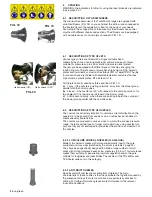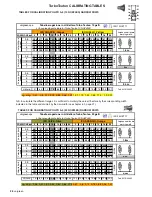
14
unigreen
4.10 FILLING THE TANK
The machines for defensive crop treatments, in consideration of the safety of
persons, animals and the protection of the environment, must only be filled
indirectly from open water courses and only by free-falling water from the
waterworks.
The pipe used for filling must never come into contact with the liquid inside the
tank and therefore the water must always fall over the upper edge of the filling inlet
and through the filter installed on it.
The tank is fitted with a transparent graduated band that shows the exact quantity
of liquid inside. This reading is precise if the tank is on flat ground; the actual total
capacity coincides with the highest number. All the filling systems fitted by
Unigreen on their production machines or on request are antipollution and stop the
liquid overflowing out of the tank.
a)
FILLING WITH THE 3-WAY DEVIATOR (Fig. 10- Fig. 11).
It is possible to fill the tank using the pump and the floating filter kit
G
(cod.1002/
0080F) with 6 metres of rubber hose (the floating filter lets you always and only
suck up clean water).
=
connect hose
T
to deviator
D
using the union hose adaptor supplied.
=
turn the lever of deviator
D
to the filling position.
=
place the other end of the hose, on which you fitted filter
G
, in the watering
point.
=
start the power-takeoff leaving pressure regulator
C
in the draining position
(you don’t have to put the pump under pressure).
=
the filling speed in litres/minute is equal to the delivery of pump
P
.
=
visually check the level of the liquid in the tank and after filling stop the pump
and put the lever of deviator
D
back in the working position.
= disconnect pipe
T
from deviator
D
.
b)
FILLING WITH THE SUCTION FILTER (Fig. 3- Fig. 11).
If the 3-way deviator isn’t fitted you can fill the tank using the coupling on the cover
of the suction filter. Unscrew the rear wing nut of the filter and using a G1"1/2
threaded union, connect pipe
T
with the floating filter to the coupling. Also in this
case the filling speed in litres/minute is equal to the delivery of the pump.
c)
FILLING WITH THE ANTIPOLLUTION EJECTOR (Fig. 12)
If you are filling with an antipollution hydroejector (mounted as standard on some
models) then you should proceed as follows:
=
put roughly 20-30 L of water in the tank and start the pump.
=
remove the cap of ejector
E
and insert filling pipe
T
.
=
place the other end of the hose, on which you fitted filter
G
, in the watering
point.
=
open the tap that supplies the ejector (on auxiliary taps, see point 4.9).
=
increase the pressure until it reaches a value which is sufficient to suck up the
liquid.
=
visually check the level of the liquid inside the tank and after filling disconnect
pipe
T
from the ejector, close the tap and replace the cap.
4.11 TEST WITH CLEAN WATER
It is good practice to do a test with clean water (without chemical product in the
tank) before the first treatment to make sure the mistblower is working properly
and to get to know the controls. For instructions on how to proceed with the
treatment see the chapter SPRAYING.
FIG. 12
FIG. 11
WARNING: using the taps on the
pump or in any case on the front of the
machine puts the operator near the
cardan shaft. Despite the presence of
protections at CE rule, it is compulsory
to switch off the engine and to take the
key off.
FIG. 10
Содержание TurboTeuton P300
Страница 35: ...unigreen 35 ...















































